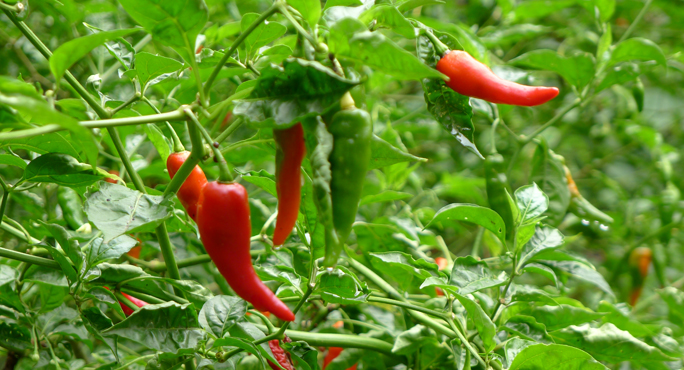Red Hot Chili Peppers. Photo by: Chris Kilham © 2009
Have you ever stood in the produce aisle of a supermarket, wondering how hot the chili peppers are? Are they mild? Are they blistering hot? How can you tell? There are many varieties of hot chili peppers, some long and some short, some green and some red. Which ones will add just the right amount of spice? Which ones will have you dialing 911?
With more than a quarter of the world’s population consuming hot chili peppers on a daily basis, there’s some hefty scientific interest in this topic. In fact, there is a well-articulated heat index (the Scoville Unit scale) by which hot chilies are measured. Some chili peppers are quite mild, while others are literally so blazing hot they should not be eaten at all, because they can burn right through the tough lining of the stomach. Ouch!
In 1912, Wilbur Scoville, a chemist working for the Parke Davis pharmaceutical company established a method for measuring the heat level of chili peppers. In his original test, Scoville blended ground chilies with a sugar-water solution in increasingly diluted concentrations. A panel of testers then sipped the various dilutions, until they reached the point at which the liquid no longer produced a burning sensation. A number was then assigned to each variety of chili based on the extent to which it needed to be diluted before you could taste no heat. Thus the Scoville Organoleptic Test was born.
Organoleptic is a term that refers to qualities that affect the senses. Perfumery relies on olfactory organoleptic testing. The quality of coffees, wines and teas are assessed by organoleptic taste tests. Color testing for paint and wallpaper is a visual organoleptic test. Organoleptic tastes are widely used in the food, beverage and fragrance industries to determine the quality of various products. Our senses are employed to determine all manner of qualities of different foods and other goods. Scoville’s organoleptic test for chili peppers established a method for measuring their heat.
Though the accuracy of the Scoville Organoleptic test has been questioned by some, chili heat is always described in terms of Scoville Units. Today the organoleptic testing procedure has been supplanted by a totally mechanical method employing High Performance Liquid Chromatography (HPLC). In this procedure, chili pods are dried, then ground.
Next, the chilies undergo a basic method of extraction, and the extract is injected into the highly sophisticated HPLC machine for analysis. This method is appreciably more costly than tasting chilies, but it results in an exact heat analysis. HPLC analysis of chilies measures the total heat of a pepper, and also quantifies the amounts of the individual capsaicinoids (hot oils) present in that variety as well. By this sophisticated method, many samples can be analyzed within a short period. Today, the assessment of chili heat is performed in a lab machine, rather than on the tongue, but Wilbur Scoville’s name lives on as the undisputed unit of heat measurement.
As a result of all these tests, various varieties of chili peppers can be ranked according to its heat or "pungency" level. The following scale comes originally from Dr. Ben Villalon of the Texas Agricultural Experiment Station. He conducted this survey of chilies and their heat, and his findings have been reprinted and reproduced thousands of times. Those of us in the chili world remain in Villalon’s debt for clearly delineating the heat levels of various chiles.
0 -100 Scoville Units: Bell/Sweet pepper varieties
500 -1000 Scoville Units: Big Jim, Anaheim peppers
1,000 -1,500 Scoville Units: Ancho, Pasilla peppers
1,500 - 2,500 Scoville Units: Sandia, Cascabel, Rocotillo peppers
2,500 - 5,000 Scoville Units: Jalapeno & Mirasol peppers
5,000 - 15,000 Scoville Units: Yellow Wax, Serrano peppers
15,000 - 30,000 Scoville Units: de Arbol peppers
30,000 - 50,000 Scoville Units: Piquin, Cayenne & Tabasco peppers
50,000 - 100,000 Scoville Units: Chiltepin, Thai, Santaka peppers
100,000 - 300,000 Scoville Units: Scotch Bonnet & Habanero peppers.
575,000 Scoville Units: Red Savina Habanero peppers.
855,000 Scoville Units: Naga Jolokia peppers (Professional pepper. Do not eat this at home).
16,000,000 Scoville Units: Pure Capsaicin (Don’t even think about it.) This is for lab research purposes only.
In 1992, salsa sales topped ketchup sales for the first time, and salsa became North America’s favorite table condiment. Apparently we increasingly favor spicy foods, and so hot chili peppers and their various preparations are selling better than ever. Now when you look at the selection of hot peppers in the produce section, or contemplate buying some dried hot chilies or some hot sauces, you’ll have a guide to aid you.
If you do find yourself with a pepper that’s just too hot in your mouth, cool down the fire with a mouthful of yogurt or a swig of full fat milk. The naturally-occurring hot oils in chili peppers are teased out of the pores of the tongue by milk fats, whereas a swig of water (a seemingly natural response) will lock the oils into the tongue and only increase the burn. Enjoy!


